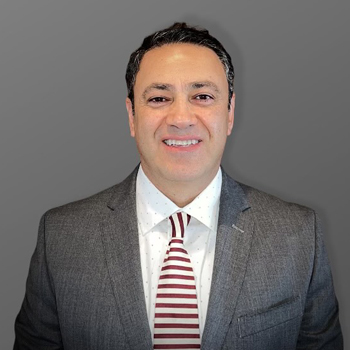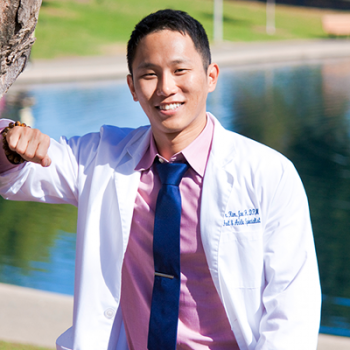Welcome to San Francisco Fungal Nail Treatment Clinic
Our mission is to provide affordable and successful treatment of your fungal toenails (onychomycosis). We also accept photographs of your toenails in order to provide you with treatment recommendations.
Understanding onychomycosis is very important to the success of your treatment. We encourage you to review the content prior to your appointment or sending us any information.
All onychomycosis can be cured, but only when the nail fungus is properly characterized and treated. Treatment options include oral anti-fungal medication, a topical anti-fungal medication, and laser. Correctly staging the severity and nature of your fungal toenails is critical in determining which treatment option is best suited for your individual needs.
We accept all major insurances. Please email or call for any questions and we will respond within 24 hours. We look forward to helping you!

Our mission is to provide affordable and successful treatment of your fungal toenails (onychomycosis). We also accept photographs of your toenails in order to provide you with treatment recommendations.
Understanding onychomycosis is very important to the success of your treatment. We encourage you to review the content prior to your appointment or sending us any information.
All onychomycosis can be cured, but only when the nail fungus is properly characterized and treated. Treatment options include oral anti-fungal medication, a topical anti-fungal medication, and laser. Correctly staging the severity and nature of your fungal toenails is critical in determining which treatment option is best suited for your individual needs.
We accept all major insurances. Please email or call for any questions and we will respond within 24 hours. We look forward to helping you!
Are you frustrated with fungail nails?
Have you tried oral, topical and laser treatment previously that was not effective? Or experienced recurrence? Many people who go through any of these treatment methods get frustrated and give-up when the fungal nail returns.
Our clinic specializes in the ultimate treatment fungal nails
We examine each toenail to see what stage of fungal infection and based on the stage of infection, we treat the nails differently: some involve topical, others involve oral and laser, and lastly a nail excision deep-cleaning procedure to give your nails a beautiful appearance.
The clinic provides treatment based on the conditions:
Our clinic offers minimally invasive procedure for nail removal with skin resurface of the nail bed to help the new nail to grow normally
Treatment Plan for Different Stages
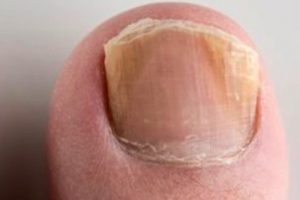
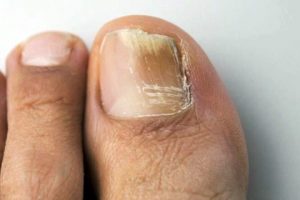
Fungalnail Stage I
Treatment options
1. Topical medication (prescription vs. over the antifungal). There are many medications available. Prescription topical anti fungal medications are generally covered by most insurance plans and more effective than over the counter topical anti fungal medications.
2. Laser treatment (the number of treatments varies depending on the severity).
- Advantage:
Success rates have been reported to vary between 70-90% effective.
(Randomized Clinical Trial to Evaluate the Efficacy and Safety of Combination Therapy with Short-Pulsed 1,064-nm Neodymium-Doped Yttrium Aluminium Garnet Laser and Amorolfine Nail Lacquer for Onychomycosis) - Disadvantage: It is not a covered benefit with insurance. The cost can vary between $300-1400, depending on the number of treatments required.
3. Oral medications (Lamisil daily for 3 months) – Advantage: The success rate varies but this study that looked at 43 different studies which included 9730 patients and found Laminal to have a 58% cure rate.
- Disadvantage: Liver damage has been reported. Sometimes the liver damage is just temporary but sometimes it is not. Careful consideration should be given to patients with pre-existing medical conditions that may increase the risk of liver damage from taking oral antifungal medication.
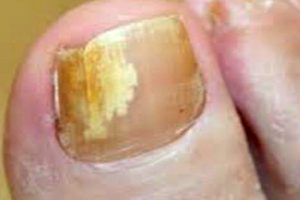
Fungalnail Stage 2
Increased migration of the fungus towards the nail root
Treatment options
1. Topical medication (over the counter topical medication is typically ineffective.)
2. Laser treatment (The number of treatments varies depending on the severity and is very efficacious.)
3. Oral medications (Lamisil daily for 3 months)
- For stage 2 It is the recommended to periodically debride (cleaning) the affected nail professionally to improve the penetration of the topical treatment. This is covered benefit by most insurances. If you don’t have health insurance, the cost ranges between $100-$150.
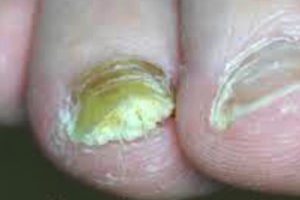
Fungalnail Stage 3
Increased thickness that extends to the nail root and brittle nature of nail in addition to infection of the nail bed.
Treatment options
1. Combination Therapy- This is very successful and includes regular debridements every 2-4 weeks with monthly laser treatments (usually at least 3), in addition to the use of daily prescription topical anti fungal medication.
2. Total Nail Rejuvenation – This is usually recommended only if the nail root is infected or successful treatment is not achieved with Combination Therapy. A toenail removal is performed in the office with local anesthesia. You are able to walk the same day and should have a full recovery in 1-2 days. A single laser treatment is usually performed 2 weeks after the toe nail is removed. Prescription anti fungal medication is applied to the nail bed until the nail grows in clear which is between 4-12 months (depending on which nail is removed.)
3. Oral medications (Lamisil daily for 3 months)
- INFECTION of the nail bed. The nail bed is a thick layer of skin that is attaching nail plate to skin
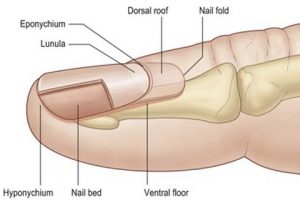
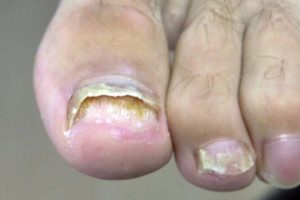
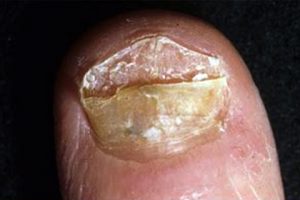
Fungalnail Stage 4-A
Significant thickness of the entire nail that is also brittle with significant infection of the nail bed. (sometimes the thickness of the nail can cause pain due to the pressure against the skin.)
Treatment options
1. Total Nail Rejuvenation – This is usually recommended for a stage IV A only if the nail root is infected. A toenail removal is performed in the office with local anesthesia. You are able to walk the same day and should have a full recovery in 1-2 days. A single laser treatment is usually performed 2 weeks after the toenail is removed. Prescription antifungal medication is applied to the nail bed until the nail grows in clear which is between 4-12 months (depending on which nail is removed.)
2. Combination therapy- This is recommended if the nail root is not infected and can be successful if the nail infection is successfully eradicated. This includes regular debridements every 2-4 weeks with monthly laser treatments (usually at least 3), in addition to the use of daily prescription topical antifungal medication.
3. Oral medications (Lamisil daily for 3 months)
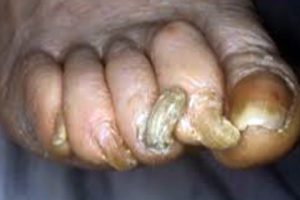
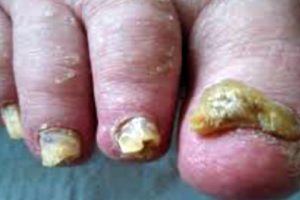
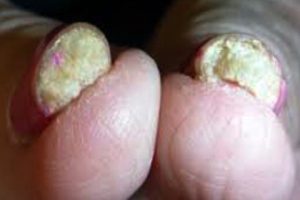
Fungalnail Stage 4-B
A significant thickness of the entire nail that is also brittle with complete infection of the nail bed and root.
Treatment options
1. Total Nail Rejuvenation – This is recommended for stage IV B. A toenail removal is performed in the office with local anesthesia. You are able to walk the same day and should have a full recovery in 1-2 days. A single laser treatment is usually performed
2. Weeks after the toenail is removed. Prescription antifungal medication is applied to the nail bed until the nail grows in clear which is between 4-12 months (depending on which nail is removed.)
3. Oral medications (Lamisil daily for 3 months)
- INFECTION of the nail bed. The nail bed is a thick layer of skin that is attaching nail plate to skin
Our physicians have successfully treated thousands of patients with nail fungus (onychomycosis). Total Nail Rejuvenation should not perform if you have severe peripheral vascular disease or any immunodeficiency.
Successful treatment is only accomplished with determining the cause and diagnosing the correct stage. Trauma, toe deformity (hammertoe) and environmental factors can all be predisposing factors in determining the cause of onychomycosis.
Persistent nail bed infections require a longer treatment period (12 months) with Combination Therapy. Please get a consultation to determine what treatments are best for you.
We accept online consultations. If you are interested please email a picture of your toenail and we would be happy to offer you a treatment plan.


